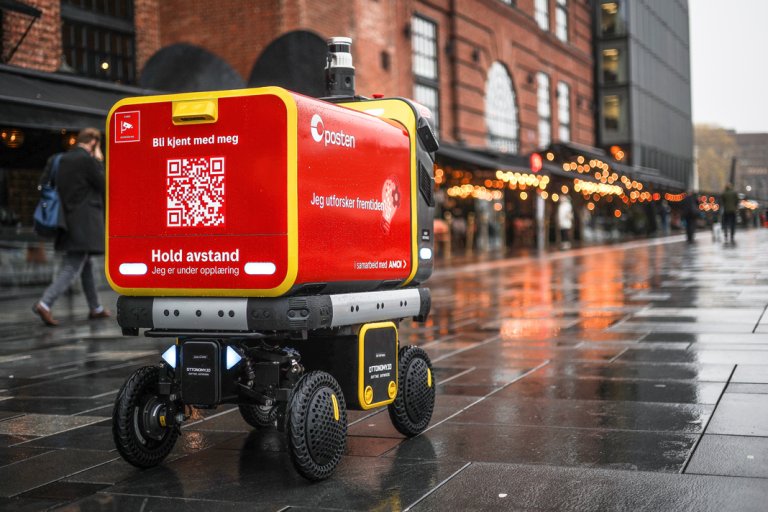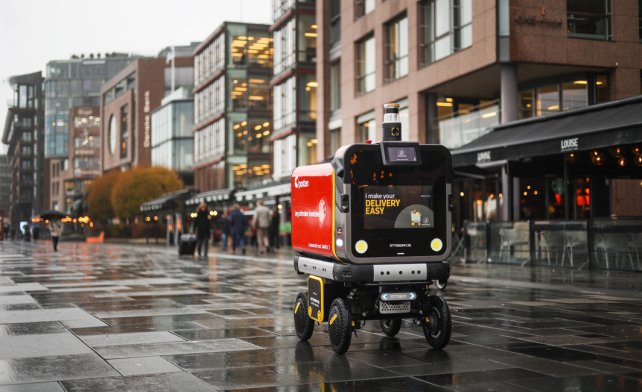Hi, I'm Ottobot!
I am Ottobot, and I am a fully autonomous robot developed to drive among pedestrians on sidewalks and in environments with mixed traffic. In November and December, you will see me driving all the way from Posten's distribution hub on Filipstadkaia, over the bridge to Aker Brygge and along the edge of the wharf to the restaurants Winther and Asia to pick up goods.
I drive on assignments from Posten and Bring in collaboration with the marketplace Amoi, so they can learn as much as possible about my technology, in which environments I do the best work and how I can help solve challenges related to deliveries and collection of goods in the future.
Why am I being tested?
The purpose of this project is simply to learn as much as possible. We want to learn how people interact with Ottobot, the maturity of the technology, and we want to explore whether Ottobot can help solve challenges in connection with picking up and delivering goods in the city.
Among other things, the project will give us insight into how the citizens of Oslo experience a robot in the urban environment, how do people feel about interacting with a robot, and whether it creates unforeseen challenges in our city. In addition, we need to understand which obstacles are difficult for the robot to maneuver, whether it can manage driving in Nordic weather conditions and how reliable Ottobot is in operation.

This project will also answer issues related to the scarcity of land, emissions, and accessibility in connection with delivery of goods in the city centre. Posten wants to be part of the solution, therefore we believe it is important to understand which combinations of automated and manual processes are suitable for delivering goods now - and in the future.
Who are the project partners?
Frequently Asked Questions
-
Ottobot was developed by Ottonomy.IO, a startup based out of Brooklyn, NY. The team at Ottonomy.IO has a background in autonomous vehicles and launched the first fully autonomous robot, Ottobot, in 2021 at the Cincinnati International Airport (CVG).
-
Yes, with the help of contextual mapping and AI Ottobot has learned to navigate in complicated traffic on its own. Advanced sensors and cameras are mounted on the robot, which enables it to "see and sense" its surroundings. Ottobot uses data from LIDAR sensors to recognize objects in traffic, such as pedestrians, bicycles, and other vehicles. It also identifies pavements, cycle lanes and motorways, as well as traffic signs and road marks. After tons of training, Ottobot has become smart enough to drive himself and make his own decisions on his way to the restaurants.
-
Ottobot is developed to drive among pedestrians and has a maximum speed of 6 km/h. However, Ottobot normally holds an average speed of 3-4 km/h.
-
Ottobot holds a net weight of approximately 100 kilos and carries goods weighing up to 80 kilos. The dimensions of Ottobot are 1110mm x 720mm x 1350mm in length, width, and height.
-
If you get within Ottobot's safety zones, it will brake and drive at a lower speed. If you get too close, Ottobot will stop and stand still until you move.
-
Ottobot has sensors that detect obstacles of all heights and sizes, so it will neither run over your child nor anyone else.
-
Ottobot is fully autonomous and does not need to be controlled by an operator, however, if something went wrong, Ottobot can trigger an alert if it should get stuck or need "help". An operator will be able to remotely control it to get it back in order or to a safer location.
-
Ottobot is equipped with a camera so the operators can override the robot's actions. Maps that are taken of the environment in which it runs are stored locally on the robot. All identifying information about people is anonymized, and the information will only be retrieved for review if an incident or situation arises that we need to learn from. Ottobot does not take pictures or store images of people.
-
The project has been approved by the Norwegian Public Roads Administration in accordance with the 'Act on the testing of self-driving vehicles'. This means that the experiment and the autonomous robots must maintain strict requirements in terms of traffic safety, privacy, and technology. In this project, our partner Holo is responsible for all formal security measures.
-
Ottobot is categorized as a machine and falls under the rules of the Machinery Directive. It is also CE-marked, which means that it meets all the requirements set by the authorities for, among other things, safety subject to the Machinery Directive.
-
Firstly, this is one of the main learning points for the project, but Ottobot has previously driven in both rain, sun, snow, and heavy wind.
-
Using the digital marketplace Amoi, the restaurants sell various food kits, cheeses and refrigerated products. In turn, Ottobot will pick up the goods sold from ASIA and Winther.
-
In this project, Ottobot will only collect goods from our selected restaurants; Asia and Winther. After the goods have been picked up, it will drive back to Posten's hub in Filipstad, where couriers will come to pick up the goods and drive them out to the end customer. Ottobot does not deliver goods to end customers for this project, only to Posten's hub. If you have ordered from the restaurants during the project period, there is a high probability that Ottobot has picked them up, but the items will be delivered home in the usual way by one of our couriers. In other words, you cannot experience order collection of your parcels with Ottobot.
-
Yes, your goods are safe with Ottobot. The goods are locked in Ottobots cabin at all times, and only our restaurants and couriers have the opportunity to open it. If your goods are not of the expected quality, please contact Amoi's customer service.
-
No, Ottobot will only be tested for a limited period so that we learn as much as possible about how people interact with the robot, how mature the technology is, and whether Ottobot can in the future help solve challenges in connection with picking up and delivering goods in the city. If Ottobot solves the tasks it is supposed to, it will help our messengers with difficult tasks and make their everyday lives easier.
-
No, you won't have to do that. If Ottobot gets stuck in the snow or other obstacles, the operators will intervene and remotely control it or come out to Ottobot to help him where it is stuck.
-
Ottobot is 100% electric, of course. Ottobot also received the 2021 Sustainability Product of the year award winner by Business Intelligent Awards. The electric driving technology helps reduce carbon footprints of the delivery process and helps organizations meet their sustainable technology and environmental goals.
-
Ottobot may operate for four hours before charging is necessary.
-
